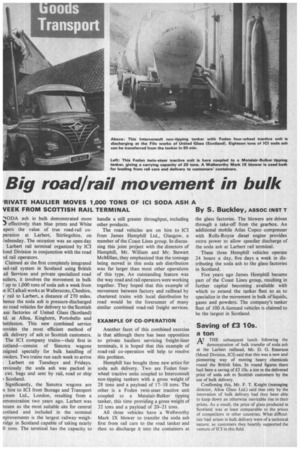Big road/rail movement in bulk
Page 20

If you've noticed an error in this article please click here to report it so we can fix it.
,RIVATE HAULIER MOVES 1,000 TONS OF ICI SODA ASH A VEEK FROM SCOTTISH RAIL TERMINAL By S. Buckley, ASSOC INST T Z1ODA ash in bulk demonstrated more 3 effectively, than blue prints and White apers the value of true road-rail coperation at Larbert, Stirlingshire, on Tednesday. The occasion was an open day : Larbert rail terminal organized by ICI fond Division in conjunction with the road -id rail operators.
'Claimed as the first completely integrated )ad-rail system in Scotland using British ail Services and private specialized road auliers, it involves the movement in bulk F up to 1,000 tons of soda ash a week from ie ICI alkali works at Wallerscote, Cheshire, y rail to Larbert, a distance of 270 miles. hence the soda ash is pressure-discharged to road vehicles for delivery to the Scottish ass factories of United Glass (Scotland) td. at Alloa, Kinghorn, Portobello and hettleston. This new combined service rovides the most efficient method of elk delivery of ash to Scottish customers. The ICI company trains—their first in cotland—consist of Simotra wagons esigned specially for bulk handling of owders. Two trains run each week to arrive
Larbert on Tuesdays and Fridays. reviously the soda ash was packed in cwt. bags and sent by rail, road or ship Scotland.
Significantly, the Simotra wagons are n hire to ICI from Storage and Transport ystem Ltd., London, resulting from a emonstration two years ago. Larbert was hosen as the most suitable site for central cotland and included in the terminal nprovements is the largest railway weighridge in Scotland capable of taking nearly 0 tons. The terminal has the capacity to handle a still greater throughput, including other products.
The road vehicles are on hire to ICI from James Hemphill Ltd., Glasgow, a member of the Coast Lines group. In discussing this joint project with the directors of Hemphill, Mr. William and Mr. Stewart McMillan, they emphasized that the tonnage being moved in this soda ash distribution was far larger than most other operations of this type. An outstanding feature was the way road and rail operators were working together. They hoped that this example of movement between factory and railhead by chartered trains with local distribution by road would be the forerunner of many similar combined road-rail freight services.
EXAMPLE OF CO-OPERATION Another facet of this combined exercise is that although there has been opposition to private hauliers servicing freight-liner terminals, it is hoped that this example of road-rail co-operation will help to resolve this problem.
Hemphill has bought three new artics for soda ash delivery. Two are Foden fourwheel tractive units coupled to Interconsult non-tipping tankers with a gross weight of 28 tons and a payload of 17-18 tons. The other is a Foden twin-steer tractive unit coupled to a Metalair-Bulker tipping tanker, this time providing a gross weight of 32 tons and a payload of 20-21 tons.
All three vehicles have a WeIlworthy Mark IX blower to transfer the soda ash first from rail cars to the road tanker and then to discharge it into the containers at the glass factories. The blowers are driven through a take-off from the gearbox. An additional mobile Atlas Cope° compresser with Rolls-Royce diesel engine provides extra power to allow speedier discharge of the soda ash at Larbert rail terminal.
These three Hemphill vehicles operate 24 hours a day, five days a week in distributing the soda ash to the glass factories in Scotland.
Five years ago James Hemphill became part of the Coast Lines group, resulting in further capital becoming available with which to extend the tanker fleet so as to specialize in the movement in bulk of liquids, gases and powders. The company's tanker fleet of 100 A-licensed vehicles is claimed to be the largest in Scotland.
Saving of E3 10s. a ton AT THE subsequent lunch following the demonstration of bulk transfer of soda ash at the Larbert railhead, Mr. D. G. Emerson (Mond Division. ICI) said that this was a new and pioneering way of moving heavy chemicals round the British Isles. In round figures there had been a saving of f3 10s. a ton in the delivered price of soda ash to Scottish customers by the use of bulk delivery.
Confirming this, Mr. F. T. Knight (managing director, Alloa Glass Ltd.) said that only by the innovation of bulk delivery had they been able to keep down an otherwise inevitable rise in their prices. As a result. the price of glass produced in Scotland was at least comparable to the prices of competitors in other countries. What difficulties had arisen in bulk delivery were of a technical nature; as customers they heartily supported the venture of ICI in this field.












































































































